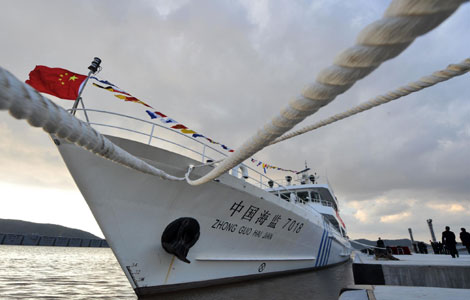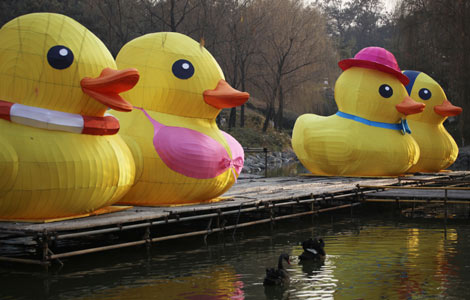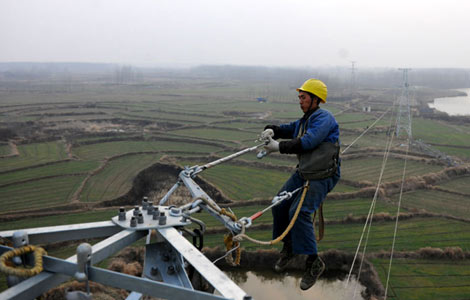

A snowboard protruded from thick snow in a corner of the courtyard outside Sengelite's house in the village of Hemu.
It was presented to the 31-year-old ethnic Tuvan man as a prize for winning a traditional skiing contest in Altay prefecture in the Xinjiang Uygur autonomous region in 2010.
While we spoke, Sengelite planed a new set of skis made from spruce. Before he nailed strips of fur to the base of the skis, he called his son Yongdeng over to see if they were long enough for the 6-year-old's rapidly growing body.
"The skis must be about 20 centimeters longer than the skier's height. Yongdeng now finds it difficult to balance on the ones I made for him when he was 3," said Sengelite, measuring the boy's height against the skis.
Winter in Hemu, hidden deep in the Altay Mountains that border Kazakhstan, Russia and Mongolia, can last as long as seven months.
The snow can reach an average depth of 1.5 meters, meaning the village is often cut off from the outside world because roads become impassable for motorized transport.
To cope with the natural environment, the Tuvan, who are believed to be a branch of the Mongolian ethnic group, developed their unique skiing techniques. Some archaeologists believe the design of the skis can be traced back to the late Paleolithic era, also known as the Old Stone Age, around 12,000 years ago, judging by a rock painting of human figures skiing discovered near Altay city, about 200 kilometers from Hemu.
 |
|
A bird's eye view of Hemu village, high in the Altay mountains in Xinjiang. |
Experts say the primitive people who lived in the Altay area were very likely the first humans to master the art of skiing, and the Tuvan still employ the same techniques as those depicted in the painting.
Unlike modern skiers, the Tuvan use a single, long wooden pole held with both hands at the back of the skis to balance and steer. They also lean most of their body weight on the pole, rather like gondoliers.
The hand-made skis with bent tips, but no overall standard design, can cross the snow just as quickly as modern skis when descending, but there's one feature of fur skis that modern-day equipment can't match - the ability to ski uphill.
"During winter, we used skis to hunt moose in the mountains, so it's essential that we're able to move both up and downhill," Sengelite said. He shouted to Yongdeng, who had been climbing a hill on his skis, and speaking in Tuvan, a language completely unrelated to modern Mongolian and with no written form, shouted encouragement, urging the boy to go even higher.
When moving uphill, the coarse fibers of the fur dig into the snow, allowing the skiers to gain the necessary purchase, but they flatten down and become slick during a descent. "The fur has to come from the forelegs of horses because the hairs are long and thick. That makes the skis fast and durable," said Sengelite, as he signaled for Yongdeng, who has been learning the Tuvan ski tradition for three years, to come down and join us.
As he descended, Yongdeng tumbled into the knee-high snow. "I want him to join the village team in the annual fur-ski competition this month, so he needs to train harder," said Sengelite, whose victory in the 10,000-meter cross-county traditional skiing competition in 2010 won him the snowboard he proudly displays at the back of his house.
To help his son with the extensive training regime, Sengelite has built two snow slopes at different angles in his backyard, training aids that many lovers of winter sports can only dream of.
Hemu hasn't had as much snow as usual this winter. "We had two meters of snow in 2012. The horses can't walk when the snow is deep, so we have to ski to and from the village center. Every household uses fur skis; we can't live without them in winter," said Sengelite.
When winter arrives, motorized vehicles are redundant, so horse sleds and fur skis become the common modes of transport in the village, which is home to around 1,200 residents, most of them Tuvan. "Modern doesn't necessarily mean better," said Sengelite, while watching horse sleds ferry fodder and people up and down the mountain, following the tracks created by the constant traffic.
All the houses in Hemu are made of wood, an easily accessible material in a village surrounded by heavily wooded mountains. The extreme slant of the roofs prevents snow from accumulating on the tops of the houses and preventing them from collapsing under the weight.







